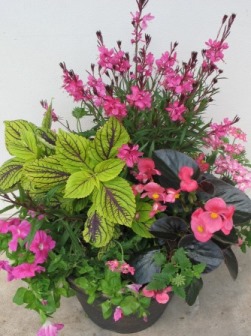
These three basic tips will help keep your containers, hanging baskets and window boxes looking great during the heat of the summer and into the fall season. For the rest of this post when we say containers, we are referring not only to them but hanging baskets and window boxes as well.
Keep well-watered
While it sounds basic enough, it’s important to keep your containers well-watered and be proactive with your watering and not wait until they are wilted. Keep in mind that while a wilted plant looks like it bounces back quickly it actually can take a number of days for a plant to totally recover. If your plants are continuously wilting, it will slow down growth as well as the number of blooms you’ll have.
If you water your containers and the water quickly runs out through the bottom, it most likely means the soil has separated from the edge of the container. Come back in about 15 minutes and water again. This will help the soil become totally saturated.
Mornings or early evenings are the best time to water your containers. Do it early enough at night so that foliage has time to dry before nightfall. This will help prevent disease problems.
Feed them
Container gardens have a limited amount of soil which in turn means there is a limited amount of nutrients available for the plants to use. Adding some time released fertilizer (Osmocote) or watering with a water-soluble fertilizer (Miracle-Gro) will give the plants a much needed boost of nutrients they need for continued growth and flower production. If you’re growing tomatoes, peppers or for that matter any vegetables in containers, giving them a boost with an organic fertilizer will also be helpful.
Grab the pruners
While a vast majority of annuals are self-cleaning meaning the flowers are sterile and the plant will just keep producing flowers there are others that should have the spent flowers removed. This is called deadheading which is just a horticultural term for removing flower heads once they are done blooming. A few that require deadheading include geraniums, salvia and ageratum. To deadhead, you can either use your fingers to pinch the flower off just below the flower head or use a pruners to do this. Deadheading encourages more flowers to be produced. A quick once-a-week deadheading of your annuals is all that is needed.
You can also use your pruners to trim plants back a bit. If those vining plants, petunias or calibrachoa are getting a bit ragged looking cut them back a bit to help rejuvenate and promote new growth. Remove no more than about 20% of the plant when cutting back. The plants might look a bit rough for a week or so after this “hair cut” but trust us they will be pushing out the blooms again in no time. The sacrifice of a few blooms now will be well worth it in the long run. You can also trim back plants that might be getting too tall in your containers. Cut them back to the desired height just above a set of leaves. The plant will send out new growth and branch out from these leaves.
